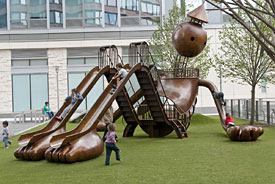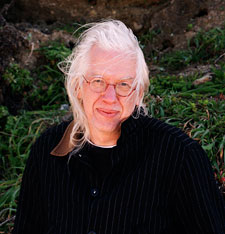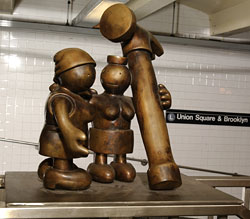Tom Otterness' Life Underground
 Playground, Edition 4/6 at 42nd Street between 11th and 12th Avenues.
Playground, Edition 4/6 at 42nd Street between 11th and 12th Avenues. Photograph courtesy of Tom Otterness
Though most public art in New York City is displayed prominently in center squares, or among the fountains of Central Park, Tom Otterness' Life Underground takes the subway. Every day, more than 30,000 people walk through the New York City subway station at 14th Street and 8th Avenue at rush hour, passing by his little bronze sculptures that are clustered throughout the station, making a statement as the riders make their way to the A train.
Hailed by The New York Times as possibly the "world's best public sculptor," Otterness' work is enormously popular. This is especially true in his adopted home, New York City, where he was the first artist ever to design a balloon for the Macy's Thanksgiving Day Parade. His work can be found all over the world, from Fulton, Mississippi to Korea. He embraces humor to interest people in his art, both because a chuckle is a good introduction to political imagery and because it encourages public art to be entertaining.
"I try to have a simple cartoon language that everybody can understand," Otterness explains about his images' straightforwardness. "The average person understands my sculpture and knows what's going on in it. Hopefully they find it funny and engage with it in a meaningful way."
 Tom Otterness
Tom Otterness Photograph by Kelly Otterness
There are more than 130 pieces included in Life Underground, the permanent installation by Otterness in the 14th Street and 8th Avenue subway station at the intersection of the A, C, E, and L lines. Inspired by the lore surrounding the creation of the subway, including urban myths familiar to New Yorkers, most of these rotund bronze figures are no more than 8 inches tall. Some are carrying oversize versions of tools used to build the subway, and some even seem to caught in the process of fabricating it, breaking into it, waiting for it, or being subsumed by a giant alligator emerging from a manhole cover.
During his initial research, Otterness became fascinated by the construction of the subway system, examining photos of the workers in the late 19th century and studying the actual tools used. He drew inspiration from the photographs, but found he was also extremely interested in another kind of public art of the time-political caricature and cartoons. Otterness poured over the drawings of Thomas Nast, a political cartoonist famous for his role in bringing down William M. "Boss" Tweed, one of the most powerful Tammany Hall leaders.
Otterness adapted moneybag heads on his sculpture in Life Underground in the spirit of Nast's imagery. Images of coins, tokens and moneybags are present in most of the figures, and are an overarching theme in most of Otterness' work.
 Bronze sculpture, part of the Life Underground series by Tom Otterness. Located at 14th Street and 8th Avenue, New York, NY
Bronze sculpture, part of the Life Underground series by Tom Otterness. Located at 14th Street and 8th Avenue, New York, NY Photograph by Patrick Cashin
The "alligator in the sewer" legend has long been fodder for New York imaginations, some suggesting they grew from abandoned pets and others denying that cold blooded reptiles could ever survive in such a climate. One of the sculptures in Life Underground can be seen crawling on the floor in futile escape from a googly-eyed sewer alligator emerging from a manhole cover. The alligator grips the man's haunches already in his toothy jaws. The fleeing figure's head is a round, full sack, cinched at the top. It is reminiscent of those seen in the hands of bank robbers in flickering Charlie Chaplin films-sans the characteristic dollar stamp. Otterness has given his alligator five-fingered human hands and a business suit. The legend takes on new meaning once you notice those details, much in the same the way you read a political cartoons.
As opposed to public art that is very self-aware of its grandeur and sophistication, Otterness' installation is folded gently into the everyday comings and goings of millions of people. The figures interact with the subway setting, some prominently displayed on main staircases while others are positioned next to existing barricades or occupying the seat next to other passengers on a wooden bench in the platform. He believes this is part of the success of his pieces, and hopes that spectators are surprised when they come across the figures and then become interested in what they might mean.
"You want to make spectators curious, and stop them, and make them think a little bit to debate the meaning," he says, suggesting that even though the images in his art are bold, that there are still many interpretations as to what they could mean. Some of the pieces in Life Underground, he adds, are just "inexplicable work," like the huge pair of totem feet on the A/C/E platform with nine total toes, both feet sharing the main toe. "I just like that people are drawn to interact with the totem feet and get photos taken on top of them. Sometimes New York doesn't make any sense at all, so that gives me room to play."
 Bronze sculpture, part of the Life Underground series by Tom Otterness.
Bronze sculpture, part of the Life Underground series by Tom Otterness. Photograph by Paul David
Life Underground took roughly ten years to bring to fruition, with the final pieces installed in the subway station in 2002. Otterness created the pieces through lost
wax casting-the process of creating a negative image in wax that is later burned away after being set in bronze.
Originally coming to New York from Wichita as a young painter, Tom Otterness is self-directed in sculpture. In his early years he made little plaster replicas of famous works that were sold in shops outside of art galleries. His affinity for sculpture and using bronze material was solidified in his early twenties when he visited Italy for the first time. He traveled to Pietrasanta, a town and commune in northern Tuscany known for its patronage of artists. He saw perfectly preserved Renaissance sculptures made of bronze and thought the quality and durability of the material was unmatched.
"I also think people just have an affinity to bronze. They want to touch it. It has a warmth and a softness that people feel connected to-that feels human in some way," says Otterness.
Recently, Tom Otterness has been creating anthropomorphized playgrounds from seated figures that are 13 feet high and 35 feet long. Children can slide down the man's bent legs and climb up into his head to look out his eyes. In the future Otterness plans to do more animation and continue to make buildings similar to the playgrounds that are "figuratives" with human qualities.
Tom Otterness will exhibit new work in a one-man show at the Marlborough Gallery on 57th Street, New York, New York in late February, 2011.
Resources:
Tom Otterness Studio, Brooklyn, NY, (718) 802-0074
Also in this Issue:
- Tom Otterness' Life Underground
- Brian Western: Giving New Life To Bottles Through Stained Glass
- Copperista: Uniquely Handcrafted Copper Creations from Amy Volchok
- Shop Profile: Signs of the Times: Atlas Signs and Plaques
- Frank Lloyd Wright Copper Urn and Other Rarities up for Auction at Christies
